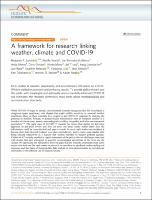Mostrar el registro sencillo del ítem
A framework for research linking weather, climate and COVID-19
| dc.contributor.author | Zaitchik, Benjamin F. | |
| dc.contributor.author | Sweijd, Neville | |
| dc.contributor.author | Shumake-Guillemot, Joy | |
| dc.contributor.author | Morse, Andy | |
| dc.contributor.author | Gordon, Chris | |
| dc.contributor.author | Marty, Aileen | |
| dc.contributor.author | Trtanj, Juli | |
| dc.contributor.author | Luterbacher, Juerg | |
| dc.contributor.author | Botai, Joel | |
| dc.contributor.author | Behera, Swadhin | |
| dc.contributor.author | Lu, Yonglong | |
| dc.contributor.author | Olwoch, Jane | |
| dc.contributor.author | Takahashi, Ken | |
| dc.contributor.author | Stowell, Jennifer D. | |
| dc.contributor.author | Rodó, Xavier | |
| dc.date.accessioned | 2021-01-06T23:10:10Z | |
| dc.date.available | 2021-01-06T23:10:10Z | |
| dc.date.issued | 2020 | |
| dc.identifier.uri | https://hdl.handle.net/20.500.12542/659 | |
| dc.description.abstract | When COVID-19 began to spread, environmental scientists recognized that the world faced a dangerous upper respiratory viral disease that might exhibit sensitivity to seasonal weather conditions. Many of these scientists have sought to aid COVID-19 response by studying the potential to monitor, forecast, or project disease transmission rates or symptom severity as a function of climate zone, season, meteorological variability, air quality, and other environmental parameters1,2,3,4. The rapid pace of COVID-19 research has meant that studies on this topic appeared on pre-print servers and then on news and social media outlets faster than the information could be cross-checked and peer-reviewed. As many such studies accumulated, it became clear that reported evidence was often contradictory, and in some cases studies were being selected subjectively in a manner that seemed intended to support political agendas. Carlson et al.5 recently provided a cogent assessment of the policy-relevant challenges associated with studies that have attempted to quantify meteorological sensitivities of the virus and the disease. We appreciate this perspective. Here we argue that the research community must act to ensure that work on this topic meets its potential to contribute to pandemic understanding and response, and that fears of inappropriate data analysis or miscommunication do not dampen innovation or the effective use of research results. | es_PE |
| dc.format | application/pdf | es_PE |
| dc.language.iso | eng | es_PE |
| dc.publisher | Nature Research | es_PE |
| dc.relation.ispartof | urn:issn:2041-1723 | |
| dc.relation.uri | https://www.nature.com/articles/s41467-020-19546-7 | es_PE |
| dc.rights | info:eu-repo/semantics/openAccess | es_PE |
| dc.rights | Reconocimiento - No comercial - Sin obra derivada (CC BY-NC-ND) | es_PE |
| dc.rights.uri | https://creativecommons.org/licenses/by-nc-nd/4.0/ | es_PE |
| dc.source | Repositorio Institucional - SENAMHI | es_PE |
| dc.source | Servicio Nacional de Meteorología e Hidrología del Perú | es_PE |
| dc.subject | COVID-19 | es_PE |
| dc.subject | Vías Respiratorias | es_PE |
| dc.subject | Medio Ambiente | es_PE |
| dc.subject | Medio Ambiente Sensible | es_PE |
| dc.subject | Meteorología | es_PE |
| dc.subject | Contaminación | es_PE |
| dc.subject | Climatología | es_PE |
| dc.subject | Environmentally | es_PE |
| dc.title | A framework for research linking weather, climate and COVID-19 | es_PE |
| dc.type | info:eu-repo/semantics/article | es_PE |
| dc.identifier.isni | 0000 0001 0746 0446 | |
| dc.description.peerreview | Por pares | es_PE |
| dc.identifier.doi | https://doi.org/10.1038/s41467-020-19546-7 | |
| dc.identifier.journal | Nature Communications | es_PE |
| dc.subject.ocde | https://purl.org/pe-repo/ocde/ford#1.05.09 | es_PE |
| dc.subject.sinia | contaminacion del aire - Aire y Atmósfera | es_PE |
| dc.type.sinia | text/publicacion cientifica | es_PE |
| dc.identifier.url | https://hdl.handle.net/20.500.12542/659 | |
| dc.identifier.url | https://hdl.handle.net/20.500.12542/659 |
Ficheros en el ítem
Este ítem aparece en la(s) siguiente(s) colección(es)
-
Artículo científico [176]









